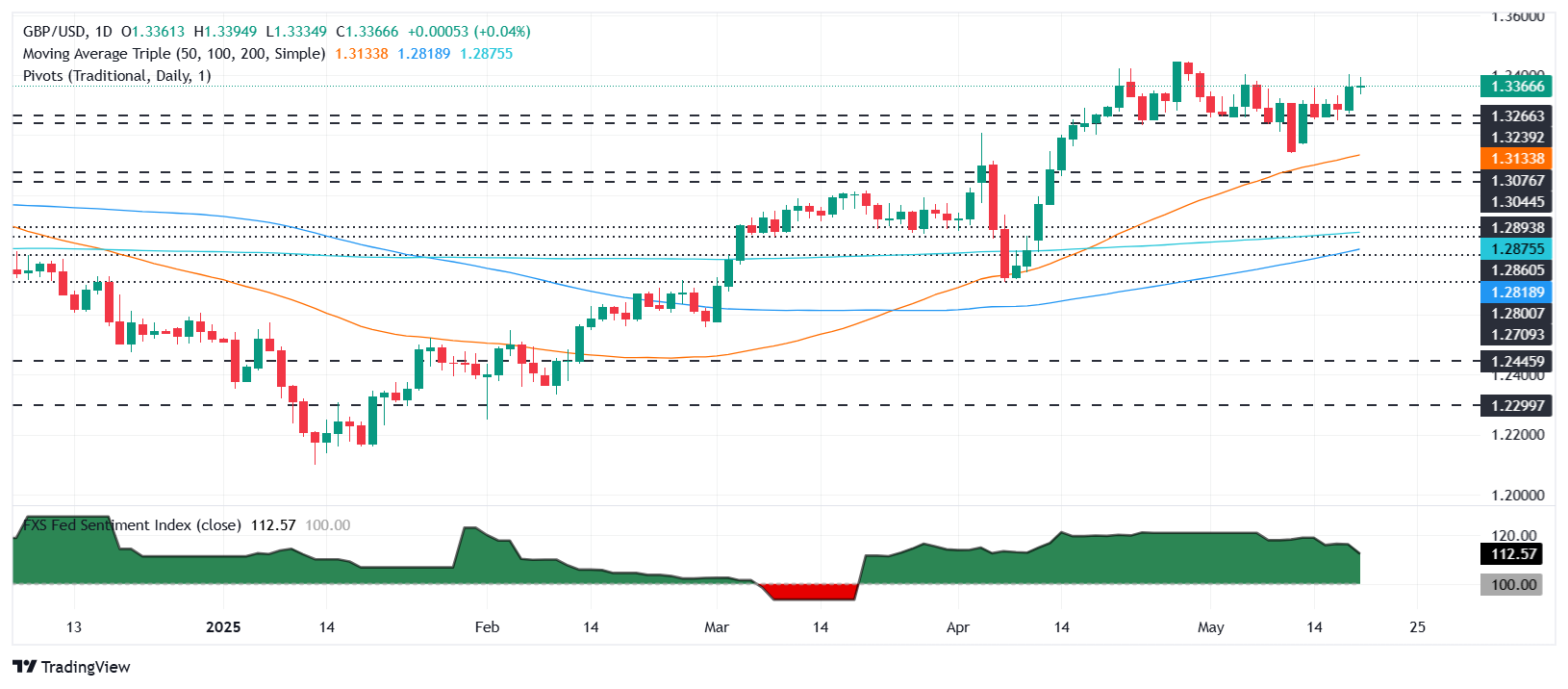GBP/USD edges up on UK-EU deal but capped by Fed hawkishness
- GBP/USD underpinned by UK-EU “reset” agreement and BoE’s Huw Pill pushing back on fast rate-cut pace.
- Market sees BoE holding in June; 41 bps of easing priced by year-end.
- US tax bill raises debt fears; DXY dips after Moody’s downgrade, but Treasury yields firm on Fed caution.
The Pound Sterling registered modest gains versus the US Dollar on Tuesday, capped by the rise of US Treasury bond yields as news of a UK-EU trade agreement boosts the prospects of the UK’s currency. Nevertheless, the Federal Reserve’s hawkish stance kept the GBP/USD from reaching the 1.3400 figure, and it traded at 1.3371 at the time of writing.
GBP/USD stays firm as upbeat UK news meets resistance from rising US yields and cautious Fed tone
News that the UK and the Eurozone (EU) struck an agreement to “reset” relations post-Brexit underpinned Cable. Additionally, Bank of England (BoE) Chief Economist Huw Pill was hawkish, stating that “the dissenting vote stems from a concern that the pace of withdrawal of monetary policy restrictions since last summer – quarterly cuts of 25bp – is too rapid, given the balance of risks to price stability."
Market players expect the BoE to hold rates at 4.25% at the June meeting, though they had priced in 41 basis points (bps) of easing towards the end of the year.
Across the pond, the US Congress continues to discuss passing the Trump tax bill, which so far hurdled the House Budget Committee. According to Reuters, “Nonpartisan analysts say the bill would add $3 trillion to $5 trillion to the nation's $36.2 trillion in debt over the next decade.”
In the meantime, the Greenback continued to recover following Moody’s downgrade of the US government debt rating from AAA to AA1, citing concerns about reducing the budget deficit.
The US Dollar Index (DXY), which tracks the buck’s value against a basket of six currencies, is down 0.16% at 100.22.
In the meantime, traders’ eyes are on the release of the UK’s inflation data on Wednesday. Later, St. Louis Fed President Alberto Musalem and Fed Governor Adriana Kugler are expected to make headlines.
GBP/USD Price Forecast: Technical outlook
The GBP/USD paused its uptrend despite remaining bullish, as portrayed by the Relative Strength Index (RSI). The RSI favors buyers, but they must clear the 1.3400 level before challenging the year-to-date (YTD) peak of 1.3443, which is followed by a target of 1.3500.
Conversely, if GBP/USD tumbles below 1.3350, the first support would be 1.3300. Once surpassed, the next stop is 1.3250, 1.3200, and the 50-day Simple Moving Average (SMA) at 1.3122.

British Pound PRICE This week
The table below shows the percentage change of British Pound (GBP) against listed major currencies this week. British Pound was the strongest against the Australian Dollar.
| USD | EUR | GBP | JPY | CAD | AUD | NZD | CHF | |
|---|---|---|---|---|---|---|---|---|
| USD | -0.66% | -0.62% | -0.46% | -0.16% | 0.07% | -0.38% | -0.66% | |
| EUR | 0.66% | 0.02% | 0.24% | 0.56% | 0.86% | 0.34% | 0.00% | |
| GBP | 0.62% | -0.02% | -0.08% | 0.56% | 0.84% | 0.32% | -0.01% | |
| JPY | 0.46% | -0.24% | 0.08% | 0.31% | 0.71% | 0.29% | -0.13% | |
| CAD | 0.16% | -0.56% | -0.56% | -0.31% | 0.25% | -0.24% | -0.53% | |
| AUD | -0.07% | -0.86% | -0.84% | -0.71% | -0.25% | -0.52% | -0.84% | |
| NZD | 0.38% | -0.34% | -0.32% | -0.29% | 0.24% | 0.52% | -0.33% | |
| CHF | 0.66% | -0.01% | 0.01% | 0.13% | 0.53% | 0.84% | 0.33% |
The heat map shows percentage changes of major currencies against each other. The base currency is picked from the left column, while the quote currency is picked from the top row. For example, if you pick the British Pound from the left column and move along the horizontal line to the US Dollar, the percentage change displayed in the box will represent GBP (base)/USD (quote).

